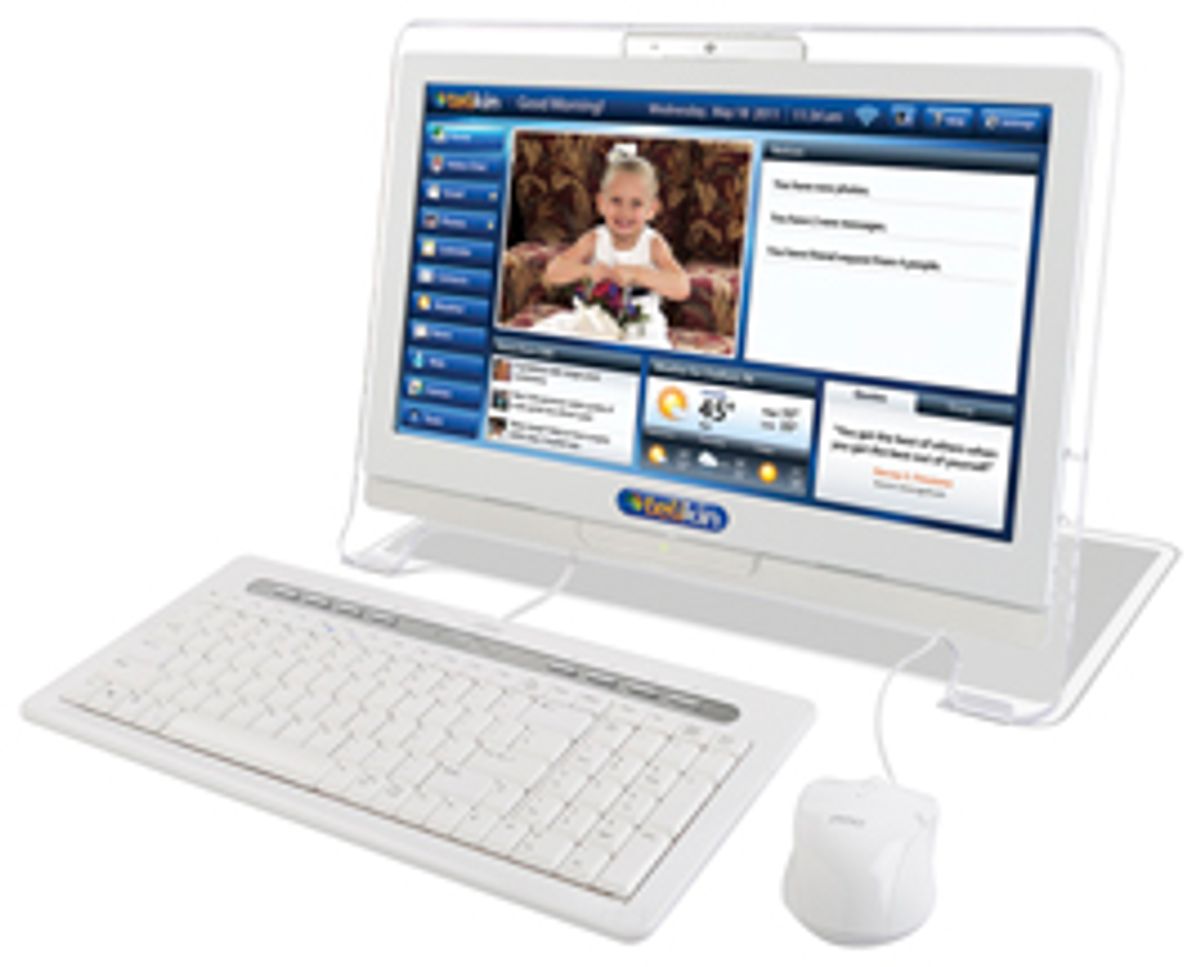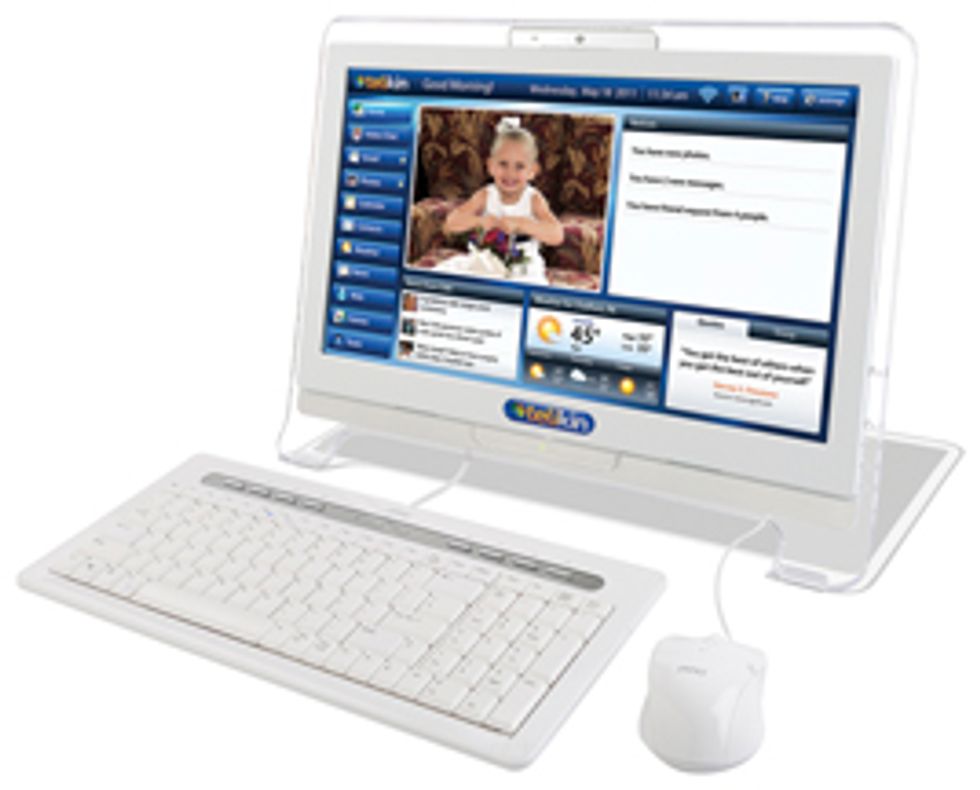In 1984, Apple's slogan was "The computer for the rest of us." Twenty-seven years later, people are still trying to build that machine—a computer for folks who really don't want to know about computers. Interestingly, the target market is exactly the same. In 1984, it was your parents, the ones whose VCR clocks forever blinked 12:00. In 2011, it's still your parents. Nowadays, their DVR always shows the right time, but they finally need a computer to keep up with you and the grandkids.
The touch-screen Telikin All-in-One is directly aimed at that demographic, and it takes a bold approach: Seniors today want to run Linux. There's no clue to what distribution it's based on, because it's been firmly locked down. You can't install software on it via any normal means, and you don't get a terminal or a file browser or even a desktop. The only way you know it's Linux is by catching the image of Tux the Penguin during an ungraceful screen flicker at boot-up.
First things first, however: Plug in the keyboard and mouse. The keys have large-print letters for failing eyesight, although the keyboard itself felt mushy. The scroll-wheel, three-button mouse feels cheap, and it tracks well on only the most mouse-friendly surfaces. Worse, the operating system supports only one button and the scroll wheel. Telikin should have gone old-school, Apple-style, with a one-button mouse.
Once the computer has booted up, a home screen displays panes of large text and a column of functions on the left for news, video chat, e-mail, and Web. A pane in the upper right tells you things you need to do, like create a user profile or set up your e-mail account. Missing, though, is a prompt to put the computer on a network, even though many of the setup tasks it suggests require network connectivity.
A complete wizard for setup would be very welcome: The target audience for this computer can't be expected to proceed without direct prompting and contextual help. Especially important in this regard is the one very nice feature that should be moved front and center. Instead, the item every savvy child of a technophobic parent desires—a remote IT function—is buried deep within a system setup menu.
Put in your info as the user's Tech Buddy and you now have an account on the Telikin support site, permitting you to take remote control of this particular machine. This feature would be needed even if the All-in-One didn't run a mysterious version of Linux that's sure to be different from anything you've ever encountered.
An hour into my exploration of the computer, I remembered one of its major features: its touch screen. Having plugged in the mouse and keyboard, I simply forgot! But I blame Telikin as well as myself—this is a computer that can't make up its mind whether to behave like a desktop or a tablet. For one thing, there's no virtual keyboard. The touch screen makes the physical mouse redundant—why not dispense with the physical keyboard as well? This uncertainty also shows itself on the software side: Click-dragging with your finger does what you would expect on a desktop machine—it selects text. But the more desirable behavior on a touch-screen device—not to mention on a machine where the emphasis is on consuming media rather than creating and editing it—is iOS‑like scrolling.
As I began to use the touch screen, my attitude toward the computer significantly improved. The screen responds well, and all the buttons and scroll bars are nicely sized for all fingers—easy to hit and not too close together. Making scroll bars unnecessary to begin with would have created a more touch-friendly interface, of course, but at least they're not a problem.
Unexpectedly, I began to compare the All-in-One to the iPad. Both try to make computing far more accessible. But iPads have small text and buttons, an elegant user interface that hides important information, icons that get all wobbly if you touch one for too long, and a penchant for deleting things after a careless poke at the screen. iPads are highly portable for folks who might not be, and yet may be too heavy for arthritic hands. The All-in-One, while not as pretty, might be a better choice for the exact market the company is targeting. The computer has a handy DVD slot, and its screen is big enough to watch movies on. In fact, the one thing it might be missing isn't the ability to run apps; it's a remote control for the DVD player.
In reviewing this sort of computer, the experienced user must put himself in a mind‑set he probably never had—that of someone truly intimidated by everything about a computer. Did Telikin do enough to assuage such a user's fears? I have to say yes: When you poke at this computer, the result is just about always what you'd expect, and I was unable to make it do anything I thought my children's grandparents would consider scary or confusing. For a senior who needs a computer for iPad-appropriate activities but for whom an iPad is unreadably small, a desktop computer with a touchscreen may be the best of all possible devices.
This article originally appeared online as "Review: The WOW Computer."
This article was updated on 31 January 2012.




